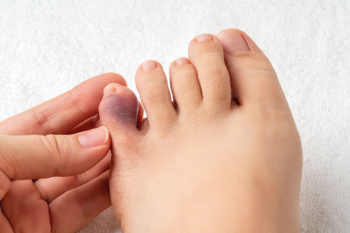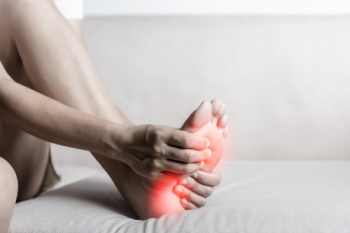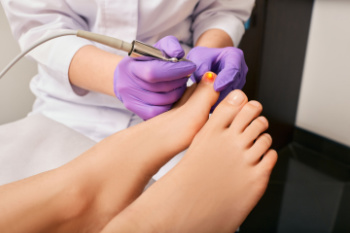Connect With Us
Blog
Items filtered by date: March 2024
Gout Pain Can Be Managed
Toe Pain and the Impact of a Broken Toe

Experiencing toe pain due to a broken toe is an all-encompassing challenge that can disrupt daily life and mobility. A broken toe, often resulting from trauma or injury, can cause sharp pain, swelling, and difficulty bearing weight on the affected foot. The pain emanates from the fracture site, creating discomfort with each step and hindering the simplest of movements. Beyond the physical sensations, the inconvenience of managing daily tasks becomes palpable, as even the act of wearing shoes can exacerbate the pain. It is important to recognize the signs of a broken toe early on and it can help to seek medical attention from a podiatrist. While the road to recovery may be challenging, understanding the nature of toe pain from a broken toe and adhering to recommended treatments can significantly enhance the healing process and minimize long-term complications. If you have endured a broken toe, it is suggested that you visit this type of doctor who can guide you toward treatment and relief techniques.
Toe pain can disrupt your daily activities. If you have any concerns, contact Imaze Marian Davis, DPM of Marian Davis, DPM, PA. Our doctors can provide the care you need to keep you pain-free and on your feet.
What Causes Toe Pain?
Most severe toe pain is caused due to a sports injury, trauma from dropping something heavy on the toe, or bumping into something rigid. Other problems can develop over time for various reasons.
Toe pain can be caused by one or more ailments. The most common include:
- Trauma
- Sports injury
- Wearing shoes that are too tight
- Arthritis
- Gout
- Corns and calluses
- Hammertoe
- Bunions
- Blisters
- Ingrown toenails
- Sprains
- Fractures (broken bones)
- Dislocations
When to See a Podiatrist
- Severe pain
- Persistent pain that lasts more than a week
- Signs of infection
- Continued swelling
- Pain that prevents walking
Diagnosis
In many cases the cause of toe pain is obvious, but in others, a podiatrist may want to use more advanced methods to determine the problem. These can range from simple visual inspections and sensation tests to X-rays and MRI scans. Prior medical history, family medical history, and any recent physical traumatic events will all be taken into consideration for a proper diagnosis.
Treatment
Treatments for toe pain and injuries vary and may include shoe inserts, padding, taping, medicines, injections, and in some cases, surgery. If you believe that you have broken a toe, please see a podiatrist as soon as possible.
If you have any questions please feel free to contact our office located in Miami, FL . We offer the newest diagnostic tools and technology to treat your foot and ankle needs.
Pregnancy and Foot Discomfort

Pregnancy is a journey filled with excitement and anticipation, but it can also bring its own set of challenges, including foot pain. Expecting mothers often find themselves dealing with discomfort and swelling in their feet, making each step a bit more challenging. However, there are ways to manage this discomfort and make the journey smoother. This can begin with investing in comfortable and supportive footwear. Opt for shoes with low heels and ample cushioning to provide relief to your tired feet. Additionally, elevating your feet whenever possible can help reduce swelling and alleviate pressure. Another helpful tip is to incorporate gentle exercises into your daily routine, such as walking or swimming, to improve circulation and strengthen your feet and ankles. Remember to stay hydrated and maintain a balanced diet to support overall health and reduce swelling. Lastly, do not hesitate to seek support from your podiatrist if foot pain becomes severe or persistent. This type of doctor can offer personalized advice and recommend safe treatment options to help you manage foot pain effectively throughout your pregnancy, If you are experiencing any foot discomfort during your pregnancy, it is suggested that you consult a podiatrist who can provide you with relief options.
Pregnant women with swollen feet can be treated with a variety of different methods that are readily available. For more information about other cures for swollen feet during pregnancy, consult with Imaze Marian Davis, DPM from Marian Davis, DPM, PA. Our doctors will attend to all of your foot and ankle needs.
What Foot Problems Can Arise During Pregnancy?
One problem that can occur is overpronation, which occurs when the arch of the foot flattens and tends to roll inward. This can cause pain and discomfort in your heels while you’re walking or even just standing up, trying to support your baby.
Another problem is edema, or swelling in the extremities. This often affects the feet during pregnancy but tends to occur in the later stages.
How Can I Keep My Feet Healthy During Pregnancy?
- Wearing orthotics can provide extra support for the feet and help distribute weight evenly
- Minimize the amount of time spent walking barefoot
- Wear shoes with good arch support
- Wear shoes that allow for good circulation to the feet
- Elevate feet if you experience swelling
- Massage your feet
- Get regular, light exercise, such as walking, to promote blood circulation to the feet
If you have any questions please feel free to contact our office located in Miami, FL . We offer the newest diagnostic and treatment technologies for all your foot and ankle needs.
Causes and Diagnosis of Foot Neuropathy

Foot neuropathy, a nerve disorder affecting the feet, can stem from various underlying causes. It presents with symptoms such as numbness, tingling, and pain. One primary cause of neuropathy is diabetes, which can lead to nerve damage over time due to high blood sugar levels. Other contributing factors include autoimmune diseases, infections, vitamin deficiencies, and traumatic injuries. To diagnose foot neuropathy, podiatrists typically begin with a thorough medical history and physical examination to assess symptoms and identify potential risk factors. Diagnostic tests such as nerve conduction studies and electromyography may be performed to evaluate nerve function and assess the extent of nerve damage. Additionally, blood tests may be conducted to check for underlying medical conditions contributing to neuropathy. Imaging studies such as MRI or CT scans may be utilized to rule out structural abnormalities or nerve compression. If you have numbness or tingling in your feet, it is suggested that you are under the care of a podiatrist who can help you to manage foot neuropathy.
Neuropathy
Neuropathy can be a potentially serious condition, especially if it is left undiagnosed. If you have any concerns that you may be experiencing nerve loss in your feet, consult with Imaze Marian Davis, DPM from Marian Davis, DPM, PA. Our doctors will assess your condition and provide you with quality foot and ankle treatment for neuropathy.
What Is Neuropathy?
Neuropathy is a condition that leads to damage to the nerves in the body. Peripheral neuropathy, or neuropathy that affects your peripheral nervous system, usually occurs in the feet. Neuropathy can be triggered by a number of different causes. Such causes include diabetes, infections, cancers, disorders, and toxic substances.
Symptoms of Neuropathy Include:
- Numbness
- Sensation loss
- Prickling and tingling sensations
- Throbbing, freezing, burning pains
- Muscle weakness
Those with diabetes are at serious risk due to being unable to feel an ulcer on their feet. Diabetics usually also suffer from poor blood circulation. This can lead to the wound not healing, infections occurring, and the limb may have to be amputated.
Treatment
To treat neuropathy in the foot, podiatrists will first diagnose the cause of the neuropathy. Figuring out the underlying cause of the neuropathy will allow the podiatrist to prescribe the best treatment, whether it be caused by diabetes, toxic substance exposure, infection, etc. If the nerve has not died, then it’s possible that sensation may be able to return to the foot.
Pain medication may be issued for pain. Electrical nerve stimulation can be used to stimulate nerves. If the neuropathy is caused from pressure on the nerves, then surgery may be necessary.
If you have any questions, please feel free to contact our office located in Miami, FL . We offer the newest diagnostic and treatment technologies for all your foot care needs.
Is Laser Treatment for Toenail Fungus Effective?

Laser treatment for toenail fungus, also known as laser therapy or laser nail therapy, has gained popularity as a non-invasive approach to combat stubborn fungal infections. This innovative procedure involves directing a concentrated beam of light onto the infected nail, which penetrates the nail bed to target and destroy the fungal organisms causing the infection. Laser therapy works by generating heat that effectively eradicates the fungus while sparing the surrounding tissue. The procedure is relatively painless and typically requires multiple sessions for optimal results. While laser treatment offers several advantages, including minimal side effects and no downtime, its effectiveness varies among individuals and depends on the severity of the infection. Additionally, laser therapy may not be suitable for everyone, and results may not be immediate, requiring patience and commitment to the treatment regimen. If you have toenail fungus and are considering laser therapy, it is suggested that you consult a podiatrist who can determine if this type of treatment is appropriate for you.
Laser treatment can be an effective way to get rid of toenail fungus. If you have any questions about laser treatment, consult with Imaze Marian Davis, DPM from Marian Davis, DPM, PA. Our doctors will assess your condition and provide you with quality treatment for fungal nails.
What Are Toenail Fungal Infections?
Onychomycosis, or fungal infection of the nail, is a relatively common and non-serious condition. Around 10 percent of U.S. citizens are afflicted with fungal nails. Common forms of fungus that infect the nail include dermatophytes, yeasts, and molds.
Symptoms of Toenail Fungal Infections Include:
- Nail thickening
- Brittleness of the nail
- Discoloration of the nail
Diagnosis for Fungal Nails
Fungal infections are diagnosed by fungal culture and microscopy. This will rule out any other conditions such as nail trauma, psoriasis, lichen planus, and onychogryphosis.
What Is Laser Treatment?
Laser treatment is a non-invasive, safe, quick, and painless procedure that uses the heat from a laser to kill fungus in the nail. Each infected nail is targeted with a laser for several minutes. The treatment is usually utilized several different times over a select period. During this time, a podiatrist will keep an eye on the infection.
If you have any questions, please feel free to contact our office located in Miami, FL . We offer the newest diagnostic and treatment technologies for all your foot care needs.


